
|
Today's Calendar |
| | Simply Economics |
| | International Perspective |
| | Resource Center |
 |
|
| 1999 Articles |
|
By Evelina M. Tainer Chief Economist, Econoday Thin markets and strong economic news derail bonds; stocks okay
Is the NASDAQ on Planet Earth? 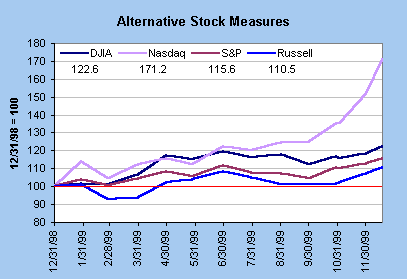 But then one looks at the NASDAQ composite, which seems to post new highs on a daily basis, and one wonders if the stock prices are posting reasonable gains. A 71.2 percent surge in the NASDAQ composite is simply remarkable. Moreover, it is important to realize that only a few key technology stocks are leading the flight up the mountain. The majority of stocks in the NASDAQ composite are more subdued. One has to wonder what will happen to this market. It defies gravity.
Brutal week for Treasury securities 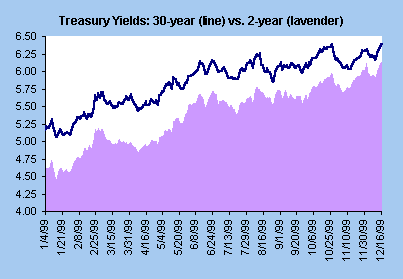
Strong retail sales set bond investors on edge early in the week 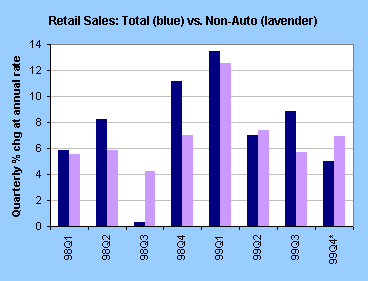 Total retail sales do matter. Indeed, the drop in auto sales in September and October is hampering the level of growth for the fourth quarter. On a total basis then, it appears that consumer spending has moderated in the final quarter of the year relative to the previous quarters of 1999. The picture is slightly different when comparing changes from a year ago. In this case, spending on nondurable goods has increased more slowly in the past two months. Durable goods have moderated in the past several months but are still zooming ahead with robust gains in both furniture (related to the housing boom) and motor vehicles. The bottom-line on retail sales? The combination of healthy sales in November with upward revisions to previous months suggests that consumer spending is not slowing down as rapidly as the Federal Reserve would like to see. This is causing fear in the hearts of bond investors who are now anticipating further rate hikes by the Fed early in 2000. Most of the world is generally assuming that the Fed would not raise rates next week so close to the end of the year (Y2K). Yet, it is certainly possible that the Fed could institute a tightening bias at the time with warnings that rate hike are on the horizon due to the strong growth.
Housing activity moderates 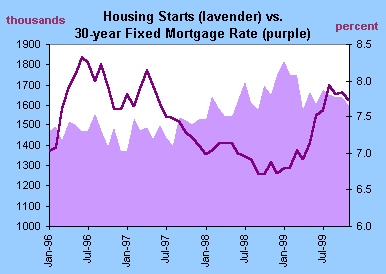 On a regional basis, starts fell in the Midwest and the South, but rose in the Northeast and West. Last week's Beige Book had indicated that supply shortages rather than lack of demand were hampering housing construction last month. Mortgage rates peaked a few months ago and have since come down from recent highs. Mortgage rates are so tightly correlated with Treasury yields that weekly changes are almost as volatile as the Treasury securities' market. The recent uptick in Treasury yields could translate into higher mortgage rates again in the next week or so. The bottom-line on housing? The Fed intended to reduce the rate of economic growth by raising the federal funds rate target (and therefore market rates) by 75 basis points these past few months. The rise in interest rates first curtails activity through interest-sensitive sectors such as housing. As housing construction moderates, then consumers will demand fewer new appliances and less furniture. This implies that retail sales should moderate in coming months - if the slowdown in housing starts is sustained, in any case.
CPI still not casualty of strong demand 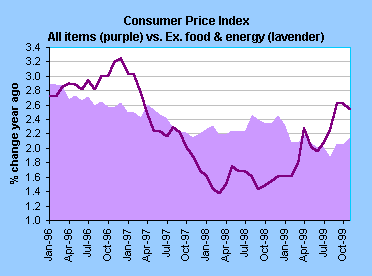 On the surface, consumer price increases still don't seem to be a problem. If you are looking for acceleration, you will find it in all the components that have some element of energy prices (e.g., fuel oil in housing, gasoline in transportation). Also, the largest gains remain in those sectors that are always a problem: tobacco, education, and medical care. The bottom-line on inflation? By itself, the November consumer price index didn't point to any severe inflation problem. However, the combination of continued strong consumer demand and pressures on energy prices is likely to worry Fed officials. Moreover, the chart above reflects an upward trend, albeit modest, in the core CPI (excluding food and energy) which they could use as an excuse to tighten policy. Incidentally, when economists initially started talking about the "core" CPI several years ago, it was to avoid the issue of volatile components in monthly data. Often, gains in one month were followed by declines in the next. However, when we look at yearly changes in the consumer price index, one should not ignore the food and energy component since these are a major portion (roughly 22 percent) of a household's budget. After all, we can't simply stop buying food or gas when prices increase. Thus, it is more appropriate to look at trends in the total CPI than the core CPI over the long run.
Production activity livens up 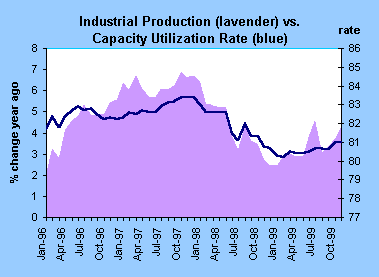 An important question is whether the pace of industrial production will continue. The Philadelphia Fed's business outlook survey tends to mirror changes in production. In December, the general conditions index fell back to 8.6 from 15.8 in November. This still represents expanding activity in the manufacturing sector. It could mean another modest gain in production for the month. 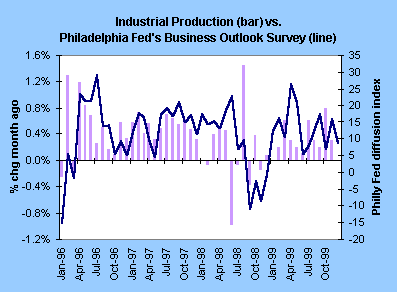 The bottom-line on production? Industrial production has become a small part of the U.S. economy. While labor shortages might affect construction and the service sector, manufacturers have shed payrolls quite steadily these past couple of years. And productivity in this sector has soared. This means that we have more opportunities for mild growth in industrial production going forward.
More red ink in foreign trade 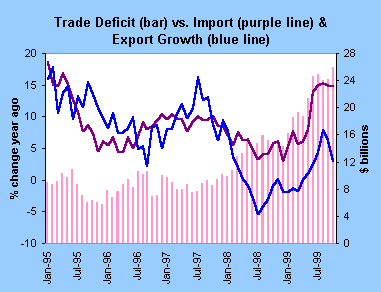 International trade deficits are always a touchy subject from a political standpoint and issues appear complex. Actually, trade is simpler to understand from an economic standpoint. Economists generally agree that trade among countries is good because it gives everyone more choice - at competitive (and lower) prices. Our trade deficit soared in the past two years because economic growth in the United States surpassed growth in foreign countries by a vast amount. Yet, the fact that we could buy imported goods at low prices held down inflation. The bottom-line on foreign trade? Increased demand for U.S. goods (exports) could put a strain on our resources going forward. At the same time, it will be interesting to see if prices of imported goods (other than oil) will increase as foreign economies grow more rapidly in the coming year. Historically, trade deficits have gotten a bum rap, but they have helped maintain our high level of consumption.
THE BOTTOM LINE As we enter the new year, market players and policy-makers will closely monitor economic indicators to see if more interest rate hikes will be necessary in February or March to curtail our booming economy. In the meantime, FOMC members will spend time at next week's meeting deciding whether they want to re-institute a "bias towards tightening" or leave things as they are.
Looking Ahead: Week of December 20 to December 24
Tuesday Market participants generally expect that the Fed will leave rates unchanged at their FOMC meeting. However, investors will be looking to see if they re-institute a tightening bias. Last week the Wall Street Journal reported that the Fed intends to start explaining their intentions more clearly and may do away with "biases" altogether. So market players are wondering whether the Fed will issue a new kind of statement with more clarity and information than the confusing "bias".
Wednesday
Thursday Market players are looking for a 0.3 percent rise in personal income in November after last month's 1.3 percent spurt (coming from special factors). At the same time personal consumption expenditures are expected to rise 0.5 percent, about the same as the past several months. Durable goods orders are expected to rise 1.1 percent in November, just about reversing the October decline. Aircraft orders surged during the month and will help propel total orders. |
||||||||||||||||||||||||||||||||||||||||||||||||||||||||||||||||||||||||||||||||||||||||||||